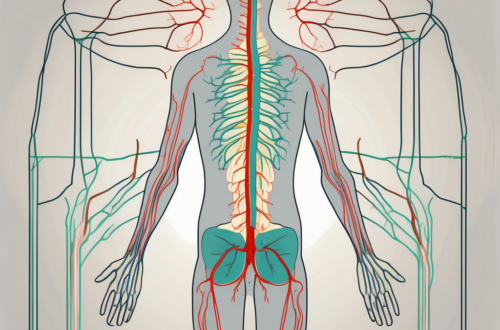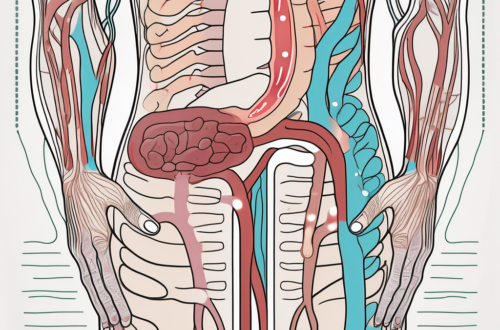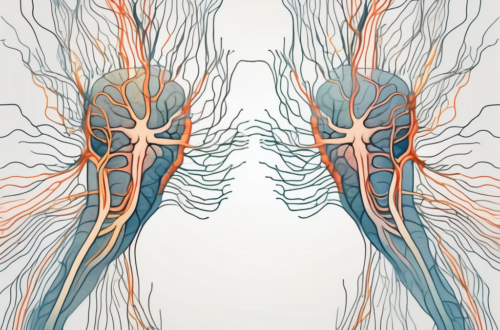The human body is a complex and intricate system, with each component playing a vital role in maintaining our overall health and well-being. One such component is the parasympathetic nervous system, specifically the parasympathetic nerve fibers in the spine. These nerve fibers are responsible for the regulation of various bodily functions, including digestion, heart rate, and glandular activity.
An Overview of the Nervous System
Before delving into the role of parasympathetic nerve fibers in the spine, it is important to have a fundamental understanding of the nervous system as a whole. The nervous system can be divided into two major components: the central nervous system (CNS) and the peripheral nervous system (PNS).
The central nervous system comprises the brain and spinal cord. The brain, often referred to as the control center of the body, is responsible for processing and interpreting information received from the sensory organs and initiating appropriate responses. It is composed of different regions, each with specific functions, such as the cerebral cortex, responsible for higher cognitive functions, and the cerebellum, responsible for coordination and balance.
The spinal cord, on the other hand, is a long, cylindrical bundle of nerve fibers that extends from the brainstem to the lower back. It serves as a conduit for signals between the brain and the rest of the body. In addition to transmitting signals, the spinal cord also plays a crucial role in reflex actions, allowing for quick responses to certain stimuli without involving the brain.
The peripheral nervous system consists of the nerves that extend from the CNS to different parts of the body. These nerves can be further divided into two main categories: cranial nerves, which originate from the brain, and spinal nerves, which originate from the spinal cord. The PNS is responsible for transmitting sensory information from the body to the CNS and carrying motor commands from the CNS to the muscles and glands.
The Central and Peripheral Nervous Systems
The central nervous system, with its intricate network of neurons, is the command center of the body. It receives information from the sensory organs, processes it, and sends out signals to initiate appropriate responses. This complex process allows us to perceive the world around us, make decisions, and carry out various actions.
The peripheral nervous system, on the other hand, acts as a communication network, connecting the CNS to the rest of the body. It is responsible for relaying sensory information from the body to the CNS, allowing us to perceive sensations such as touch, pain, and temperature. It also carries motor commands from the CNS to the muscles and glands, enabling us to move and perform various bodily functions.
Within the peripheral nervous system, there are two main divisions: the somatic nervous system and the autonomic nervous system (ANS). The somatic nervous system controls voluntary movements and is responsible for our ability to consciously control our skeletal muscles. It allows us to perform actions such as walking, talking, and writing.
The Autonomic Nervous System: Sympathetic and Parasympathetic
The autonomic nervous system (ANS) is a crucial part of the peripheral nervous system and is responsible for regulating involuntary functions of the body. It controls processes that occur automatically, without conscious effort, such as heart rate, digestion, and breathing.
The ANS is further subdivided into two branches: the sympathetic nervous system and the parasympathetic nervous system. These two branches work in opposition to each other, maintaining a delicate balance to ensure the body functions optimally in different situations.
The sympathetic nervous system is often referred to as the “fight or flight” response system. It prepares the body for action in times of stress or danger. When activated, it increases heart rate, dilates blood vessels, and redirects blood flow to the muscles, enabling us to respond quickly and effectively to perceived threats.
On the other hand, the parasympathetic nervous system is often referred to as the “rest and digest” response system. It promotes relaxation and conserves energy. When activated, it slows heart rate, constricts blood vessels, and stimulates digestion, allowing the body to rest, recover, and carry out essential functions such as nutrient absorption and waste elimination.
Overall, the nervous system is a complex and intricate network that allows us to perceive, interpret, and respond to the world around us. From the central nervous system, which processes information and initiates responses, to the peripheral nervous system, which connects the CNS to the rest of the body, each component plays a vital role in maintaining our overall well-being and ensuring our bodies function optimally.
The Anatomy of Parasympathetic Nerve Fibers
Now that we have a basic understanding of the nervous system and the role of the parasympathetic nervous system, let’s take a closer look at the anatomy of parasympathetic nerve fibers in the spine.
The parasympathetic nervous system, often referred to as the “rest and digest” system, plays a crucial role in maintaining homeostasis in the body. It works in opposition to the sympathetic nervous system, which is responsible for the “fight or flight” response. The parasympathetic system helps to conserve energy and promote relaxation by slowing down heart rate, increasing digestion, and promoting restful sleep.
Origin and Pathways of Parasympathetic Nerves
The parasympathetic nerve fibers originate from the brainstem and the sacral region of the spinal cord. From the brainstem, these fibers travel through various cranial nerves to innervate specific organs and tissues. For example, the vagus nerve, the longest cranial nerve, carries parasympathetic fibers to the heart, lungs, and digestive system. This intricate network of fibers allows for precise control and regulation of bodily functions.
From the sacral region of the spinal cord, the parasympathetic fibers emerge and travel to the pelvic organs. These fibers form the pelvic splanchnic nerves, which innervate the bladder, reproductive organs, and parts of the large intestine. The parasympathetic system plays a vital role in sexual arousal and reproductive functions, as well as maintaining bladder control and promoting healthy bowel movements.
Parasympathetic Nerve Fibers in the Spinal Cord
In addition to their origin in the brainstem and sacral region, parasympathetic nerve fibers also have a presence in the spinal cord. These fibers are intimately connected with the spinal nerves, allowing for coordinated regulation of bodily functions.
The spinal cord, a long, cylindrical bundle of nerve fibers, is a crucial component of the central nervous system. It extends from the base of the brain down to the lower back and is protected by the spinal column. Within the spinal cord, the parasympathetic fibers intermingle with the spinal nerves, forming complex networks known as the autonomic plexuses.
These autonomic plexuses, such as the cardiac plexus and the celiac plexus, serve as control centers for various organs and tissues. They receive signals from the parasympathetic nerve fibers and coordinate the appropriate responses. For example, the cardiac plexus regulates heart rate and rhythm, while the celiac plexus controls digestion and blood flow to the abdominal organs.
The integration of parasympathetic nerve fibers within the spinal cord allows for efficient communication and coordination between different parts of the body. This intricate network ensures that the parasympathetic system can respond quickly and appropriately to changes in the internal and external environment.
The Role of Parasympathetic Nerve Fibers in the Spine
Now that we have explored the anatomy of parasympathetic nerve fibers in the spine, let’s dive into their role in regulating bodily functions.
Regulation of Bodily Functions
Parasympathetic nerve fibers play a crucial role in the regulation of various bodily functions. These fibers are responsible for stimulating digestion, controlling heart rate, and promoting glandular activity in different organs.
For instance, when we consume a meal, parasympathetic nerve fibers facilitate the release of digestive enzymes, promoting efficient breakdown and assimilation of nutrients. These fibers work in coordination with the enteric nervous system, which is responsible for the intricate movements of the gastrointestinal tract, ensuring proper digestion and absorption of nutrients.
Furthermore, these fibers also slow down the heart rate after moments of increased sympathetic activity, ensuring a balanced and healthy cardiovascular system. By releasing acetylcholine, a neurotransmitter that acts on the heart’s pacemaker cells, parasympathetic fibers help regulate the heart’s rhythm and maintain optimal blood flow throughout the body.
In addition to their role in digestion and cardiovascular regulation, parasympathetic nerve fibers also play a crucial role in promoting glandular activity. These fibers innervate various glands, such as the salivary glands, lacrimal glands, and digestive glands, stimulating the secretion of saliva, tears, and digestive enzymes, respectively. This ensures proper lubrication, moisture, and enzymatic breakdown of food, facilitating the overall digestive process.
Response to Stress and Relaxation
Parasympathetic nerve fibers also play a significant role in our body’s response to stress and relaxation. During periods of stress, the sympathetic nervous system dominates, preparing the body for action. The release of stress hormones, such as adrenaline and noradrenaline, triggers the “fight-or-flight” response, increasing heart rate, dilating blood vessels, and redirecting blood flow to the muscles.
However, once the stressful situation subsides, parasympathetic fibers are responsible for restoring a state of relaxation and tranquility. These fibers counteract the effects of the sympathetic nervous system by releasing acetylcholine, which slows down the heart rate, constricts blood vessels, and promotes a sense of calmness.
Moreover, parasympathetic fibers also contribute to other relaxation responses in the body. They stimulate the release of endorphins, which are natural painkillers and mood enhancers, promoting a sense of well-being and reducing anxiety. Additionally, these fibers regulate the constriction of the pupils, promoting visual clarity and focus during relaxed states.
In conclusion, parasympathetic nerve fibers in the spine play a vital role in regulating bodily functions, including digestion, cardiovascular activity, and the body’s response to stress and relaxation. Understanding the intricate workings of these fibers provides valuable insights into maintaining overall health and well-being.
Disorders Related to Parasympathetic Nerve Fibers in the Spine
Despite the vital role played by parasympathetic nerve fibers in maintaining our health, disorders affecting these fibers can have significant consequences on our well-being. The parasympathetic nervous system is responsible for regulating various bodily functions, including digestion, heart rate, and sweating. When these nerve fibers in the spine are disrupted, it can lead to a range of symptoms and challenges.
One common symptom of disorders related to parasympathetic nerve fibers in the spine is gastrointestinal disturbances. These disturbances can manifest as constipation or diarrhea, causing discomfort and affecting the overall quality of life. Additionally, abnormal heart rate, known as arrhythmia, can also be a symptom of such disorders. This irregularity in heart rhythm can be concerning and may require medical attention.
Excessive sweating, medically known as hyperhidrosis, is another symptom that individuals with disorders affecting parasympathetic nerve fibers may experience. This condition can be socially distressing and may interfere with daily activities and personal relationships. Understanding and managing these symptoms is crucial for individuals to regain control over their lives.
Symptoms and Diagnosis
Diagnosing disorders related to parasympathetic nerve fibers in the spine can be complex. Healthcare professionals often conduct a comprehensive evaluation of the patient’s medical history, considering any previous conditions or injuries that may have contributed to the development of these disorders. A thorough physical examination is also conducted to assess the patient’s overall health and identify any specific symptoms.
In some cases, specialized tests may be necessary to confirm the diagnosis. These tests can include nerve conduction studies, which measure the electrical activity of the nerves, and imaging scans, such as magnetic resonance imaging (MRI) or computed tomography (CT) scans, to visualize the spine and identify any abnormalities or damage to the nerve fibers.
Treatment and Management
When it comes to the treatment and management of disorders related to parasympathetic nerve fibers in the spine, a multidisciplinary approach is often employed. Healthcare professionals from various specialties collaborate to develop a comprehensive treatment plan tailored to the individual’s needs.
Lifestyle modifications play a crucial role in managing these disorders. This can include dietary changes to address gastrointestinal disturbances, such as increasing fiber intake for constipation or avoiding trigger foods for diarrhea. Regular exercise and stress reduction techniques may also be recommended to help regulate heart rate and reduce excessive sweating.
Medication can be prescribed to alleviate specific symptoms or target the underlying cause of the disorder. For example, medications that promote bowel movements may be prescribed for constipation, while medications that regulate heart rate may be used for arrhythmia. In some cases, surgical interventions may be necessary to repair or remove any structural abnormalities in the spine.
Physical therapies, such as physiotherapy or occupational therapy, can also be beneficial in managing these disorders. These therapies focus on improving muscle strength, flexibility, and overall physical function. They may also include techniques to enhance nerve regeneration and improve the communication between nerve fibers.
It is essential for individuals experiencing symptoms related to disorders affecting parasympathetic nerve fibers in the spine to consult with a healthcare professional. Only a qualified medical practitioner can provide tailored advice and guidance based on the individual’s specific needs and circumstances. With proper diagnosis and management, individuals can regain control over their health and improve their overall well-being.
Future Research Directions in Parasympathetic Nervous System
As our understanding of the parasympathetic nervous system continues to evolve, it opens up new avenues for future research and potential therapeutic applications.
The parasympathetic nervous system, often referred to as the “rest and digest” system, plays a crucial role in maintaining homeostasis in the body. It is responsible for conserving energy, promoting digestion, and regulating various bodily functions. While much progress has been made in unraveling the mysteries of this intricate system, there is still much to learn.
Potential Therapeutic Applications
Recent research has shown promising therapeutic potential in manipulating the parasympathetic nervous system for the treatment of various medical conditions. For example, stimulating parasympathetic activity has been explored as a potential approach for managing conditions such as irritable bowel syndrome and certain cardiovascular disorders.
In the case of irritable bowel syndrome (IBS), studies have suggested that enhancing parasympathetic activity can help alleviate symptoms such as abdominal pain, bloating, and altered bowel habits. By modulating the parasympathetic nervous system, researchers hope to provide relief to the millions of individuals affected by this chronic gastrointestinal disorder.
Furthermore, certain cardiovascular disorders, such as hypertension and heart failure, have been associated with autonomic dysregulation. By targeting the parasympathetic nervous system, researchers aim to restore balance and improve cardiovascular function. This approach holds great promise for the development of novel therapeutic interventions.
Challenges and Opportunities in Research
While the field of parasympathetic nervous system research holds great promise, it also presents its fair share of challenges and opportunities. Understanding the intricate mechanisms underlying the regulation of parasympathetic nerve fibers and their interaction with other bodily systems requires further investigation.
One area of interest is the exploration of the gut-brain axis, which involves bidirectional communication between the central nervous system and the gastrointestinal tract. The parasympathetic nervous system plays a vital role in this axis, influencing gut motility, secretion, and immune function. Unraveling the complexities of this interaction could lead to breakthroughs in the treatment of gastrointestinal disorders.
Additionally, exploring the potential for targeted therapies while avoiding unintended side effects is a priority for future research endeavors. Manipulating the parasympathetic nervous system must be done with precision to ensure the desired therapeutic effects without disrupting other essential bodily functions.
Moreover, investigating the role of the parasympathetic nervous system in mental health disorders, such as anxiety and depression, presents a fascinating avenue for future research. Understanding the interplay between the parasympathetic system and the brain could potentially lead to innovative therapeutic approaches for these prevalent conditions.
In conclusion, the role of parasympathetic nerve fibers in the spine is crucial for the regulation of bodily functions and maintaining overall health. Understanding the anatomy, function, and disorders related to these nerve fibers provides valuable insights into the intricate workings of the human body. If you are experiencing any symptoms or concerns related to parasympathetic nerve fibers, it is important to consult with a healthcare professional who can provide expert guidance and care tailored to your specific needs.





